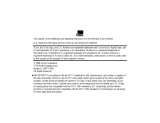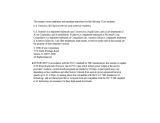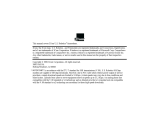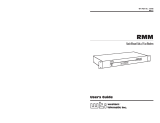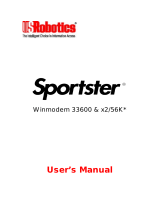Page is loading ...

This manual covers installation and operating instructions for the following 3Com modems:
Sportster
®
33.6 kbps internal and external modems
3Com, the 3Com logo, U.S. Robotics, the USRobotics logo, and Sportster are registered
trademarks; Connections, Total Control, Courier, RapidComm, x2, and the x2 logo are trademarks
and Towne Square 2000 is a service mark of 3Com Corporation or its subsidiaries. Windows and
Internet Explorer are registered trademarks of Microsoft Corp. CompuServe is a registered
trademark of CompuServe Inc. America Online is a registered trademark of America Online Inc.
Netscape Navigator is a trademark of Netscape Communications Corp. Any other trademarks, trade
names, or service marks used in this manual are the property of their respective owners.
Copyright © 1997 3Com Corporation or its subsidiaries
7770 North Frontage Road
Skokie, IL 60077-2690
All Rights Reserved

TABLE OF CONTENTS
ii
Before You Begin (Windows 95 Users) 1
Internal Modem Installation with Windows 3.x 4
A Word about COM Ports and IRQs 4
How to Use ComTest to Determine Your Modem’s Settings 6
Testing an Installed Modem 9
What to Do with ComTest’s Recommendation 9
How to Change the Modem’s Settings 12
How to Insert the Modem into the Computer 14
Internal Modem Installation with Windows 95 21
Plug and Play Installation 21
How to Prepare for Plug and Play Installation 21
How to Insert the Modem into the Computer 23
Installing the Modem Drivers 27
External Modem Installation with Windows 3.x 35
How to Determine Which Serial Cable to Buy 35
How to Connect the Modem to the Computer 36

TABLE OF CONTENTS
iii
External Modem Installation with Windows 95 39
How to Determine Which Serial Cable to Buy 39
How to Connect the Modem to the Computer 40
Installing the Modem Drivers 42
Manual Modem Installation 50
Software Installation and Testing 58
Software Installation and Registration Using the Setup Wizard 58
Sending Your First Fax 74
Installing Other Fax/Data Software 77
Type of Modem 77
Initialization String 77
Flow Control 77
UART (External Modems Only) 78
Using Modem Station 79
Why Modem Station? 79
What Does Modem Station Do? 79
Installing Modem Station 79
Starting Modem Station 82
Using Detect New Modems 84
Using Terminal 86
Using Modem Configurator 88

TABLE OF CONTENTS
iv
Using Modem to Computer 91
Using the Extended Information Screens 96
U.S. Robotics Modem Update Wizard 103
Installation 103
Operation 108
Troubleshooting and Online Help Resources 116
Online Help Resources 122
Are You Still Having Problems? 126
If You Need to Return the Modem to Us 127
RapidComm Troubleshooting Tips 127
A Note to Users with Older Versions of RapidComm on Their Systems 128
Glossary 129
Technical Quick Reference 143
Front Panel Lights (External Modems) 144
Command Summary 145
DIP Switches (Modems with DIP Switches Only) 160
S-Registers 162
The Serial Interface 172
Regulatory Information 174
Manufacturer’s Declaration of Conformity 174
Caution to the User 175

BEFORE YOU BEGIN
1
Your Sportster modem is a Plug and Play
device. Windows
®
95 can automatically
identify a Plug and Play device and determine if
your system has the resources necessary to
support the device. However, Plug and Play
will not work if you do not have resources
available or if devices on your system are not
reporting resource usage correctly. Here’s
how you can verify that your system has the
necessary resources before installing the
modem.
1. Click the Windows 95 Start button, point
to Settings, and then click Control Panel.
2. Double-click the System icon.
3. When the “System Properties” screen
appears, click the Device Manager tab.
4. Double-click Computer and the
“Computer Properties” screen appears.
5. Select the option at the top of the screen to
show Interrupt Requests (IRQs).
You will see the IRQs your system is currently
using. If IRQs 3, 4, 5, and 7 are being used,
you need to free an IRQ before you begin
installation. This process involves moving a
device from the IRQ you want to use to a
different (and usually higher) IRQ setting.
Please read the documentation for (or contact
the manufacturer of) the device that is currently
using the IRQ you want to use for your modem
to learn more about what you should do to free
the IRQ for your modem.
Be sure to read the section titled “U.S.
Robotics Modem Update Wizard” on page
101 for information on upgrading your 33.6
faxmodem to x2
™
technology, allowing
downloads of up to 56 kbps.

BEFORE YOU BEGIN
2
Determining Your Version of
Windows 95
Follow these steps to determine your version
of Windows 95. This information will be
important during installation.
1. Click the My Computer icon on your
desktop with the right mouse button.
2. Click Properties.
3. In the “System Properties” screen, look at
the system information under the General
tab (circled in the following screen image).
The number following the text “Microsoft
Windows 95” will end with “950”, “950a”,
or “950b”. This indicates your version of
Windows 95. Write this number on the
blank below for later reference. Then click
OK.
Windows 95 version _________________

BEFORE YOU BEGIN
3
Upgrading to x2
™
Technology
Be sure to read the section titled “U.S.
Robotics Modem Update Wizard” on page
101 for information on upgrading your 33.6
faxmodem to x2
™
technology, allowing
downloads of up to 56 kbps*.
∗ IMPORTANT! All x2 products are capable of 56
kbps downloads; however, due to FCC rules which restrict
power output of the service providers' modems, current
download speeds are limited to 53 kbps. Actual speeds
may vary depending on line conditions. Uploads from
users to service providers travel at speeds up to 28.8
kbps. An x2-capable modem, an x2-compatible analog
phone line, and an x2-capable Internet Service Provider are
necessary for these high-speed downloads.

INTERNAL MODEM INSTALLATION WITH WINDOWS
®
3.X
4
You’ll need these items from your
Sportster
®
modem box:
modem phone cord
Connections
™
CD
Plus:
a screwdriver (not included)
A Word about COM Ports
and IRQs
Most computer accessories — a mouse,
sound card, enhanced graphics card, scanner,
etc. — require a special connection through
which they can communicate with the
computer. For some devices, this connection is
called a communications (or COM) port. Most
computers have 1 or 2 COM ports, but they
can have up to 4. Although internal modems
do not connect to COM ports directly, they do
require a COM port setting, which is
determined by the setting on the modem’s
COM jumper pins.

INTERNAL MODEM INSTALLATION WITH WINDOWS 3.X
5
Each COM port uses an interrupt request
(IRQ). An accessory uses an IRQ to get the
attention of your computer’s centralprocessing
unit (CPU) so that the accessory can perform
a task. The computer stops what it’s doing,
depending on the priority of the request, to
help the accessory perform its task. When two
accessories share an IRQ, it’s like two people
asking different questions in unison to a third
person. Just as the person being asked the two
questions cannot understand either request, a
computer can lock up or otherwise fail to
communicate properly with your modem when
there is an IRQ conflict.
D KEY POINT: Accessories cannot
share COM ports and should not share
IRQs. When accessories try to share
settings, they will either not work
properly or not work at all. This section
of the manual will help you understand
the COM/IRQ settings on your new
Sportster modem.
U.S. Robotics has set your modem to a default
Plug and Play setting geared towards
Windows 95 users. In this configuration, the
shunts used to set your modem’s COM port
and IRQ settings are hanging from single
jumper pins and will not affect your modem’s
settings. As a Windows 3.x user, you need to
run the ComTest program (on the
Connections CD) to determine what settings
your modem should use.

INTERNAL MODEM INSTALLATION WITH WINDOWS 3.X
6
NOTE: Some communications
software programs require a particular
setting for your modem (RapidComm,
which shipped with your modem, does
not). If you wish to use a program other
than RapidComm, now is a good time to
read that software’s manual to
determine what setting is required.
How to Use ComTest to
Determine Your Modem’s
Settings
1. Insert the Connections CD into your CD-
ROM drive.
2. In Windows’ Program Manager, click Run
on the File menu. Type d:\comtest.exe
and press ENTER. This starts ComTest,
the program that determines which COM
ports and IRQs are available for use by
your modem.
3. The screen in the next column appears
when ComTest starts.
• If there is a modem in your computer
which you are replacing with your new
Sportster modem, go to “Testing an
Installed Modem” on page 7 to
determine which COM and IRQ settings
the older modem is using.
• If a modem is not currently installed in
your computer, click Recommend
settings for a new modem.

INTERNAL MODEM INSTALLATION WITH WINDOWS 3.X
7
Then click Next.
4. Click Internal Modem. Then click Next.
5. If you have a free setting, you will see a
screen like this.
COM2/IRQ3 is free in this example.
ComTest might instead recommend
COM1/IRQ4, COM3/IRQ4, or
COM4/IRQ3 for your modem.
Write down the displayed settings in the
spaces provided on the first page of this
manual. You’ll need to know these settings
later. Click Next.

INTERNAL MODEM INSTALLATION WITH WINDOWS 3.X
8
If you do not have a free setting, you will
see a screen like this.
Click Finish to exit ComTest. Go to “What
to Do with ComTest’s Recommendation”
on page 8.
6. When you see this screen, click Finish to
exit ComTest.
Go to “What to Do with ComTest’s
Recommendation” on page 8.

INTERNAL MODEM INSTALLATION WITH WINDOWS 3.X
9
Testing an Installed Modem
If there is a modem already installed in your
computer, you can determine its COM and
IRQ settings by selecting the Test an
installed modem option. Follow the
instructions on screen until you see the screen
that tells you “Testing is complete.” This screen
will also tell you which COM and IRQ settings
your present modem is using. These are the
settings you want to use for your new
Sportster modem. Write the settings down in
the spaces provided on the first page of this
manual.
Turn off and unplug your computer and
remove your present modem. Go to “How to
Change the Modem’s Settings” on page 10.
What to Do with ComTest’s
Recommendation
NOTE: If your communications
software requires a modem that
ComTest does not recommend, there is
a good chance that the setting is being
used by another device in your system.
To free that setting in your system,
consult your computer’s manual. Go to
“How to Change the Modem’s Settings”
on page 10.
If ComTest recommended COM1/IRQ4
Write “COM1” and “IRQ4” in the spaces
provided on the first page of this manual. Go to
“How to Change the Modem’s Settings” on
page 10.

INTERNAL MODEM INSTALLATION WITH WINDOWS 3.X
10
If ComTest recommended COM2/IRQ3
Write “COM2” and “IRQ3” in the spaces
provided on the first page of this manual. Go to
“How to Change the Modem’s Settings” on
page 10.
If ComTest recommended COM3/IRQ4
or COM4/IRQ3
Do not use either of these settings. While the
COM port part of the setting is acceptable
(ComTest only recommends COM ports that
are not being used), the IRQ part of the setting
is not acceptable. When ComTest
recommends either COM3/IRQ4 or
COM4/IRQ3, the IRQ in the setting is being
used by another accessory. You could use the
suggested IRQ for the modem, but you run the
risk that the modem and/or the other accessory
sharing the IRQ might not work properly.
If you do not have a sound card, use
COM3/IRQ5. Write “COM3” and “IRQ5”
in the spaces provided on the first page of
this manual. You will have to change the
settings on your modem. Go to “How to
Change the Modem’s Settings” on page 10.
If you do have a sound card, use
COM2/IRQ3. To use this setting, you have to
first disable your computer’s second serial port
(COM2). This is a pronged socket on the
back of your computer.
• Go to your computer manufacturer’s
manual.
• Find out how to disable the COM port.
• Find out which of the sockets on the back
of your computer is the second serial port.
• If you have something plugged into that
port, find out if you can plug it in
somewhere else. Any accessory plugged

INTERNAL MODEM INSTALLATION WITH WINDOWS 3.X
11
into that port will not work after the port
has been disabled.
• Then return to this point in this manual to
continue.
After disabling COM2, you can use the
COM2/IRQ3 setting.
Write “COM2” and “IRQ3” on the first page
of this manual and go to “How to Change the
Modem’s Settings” on page 10.
If ComTest reports that “You do not
have any available COM ports and/or
IRQs”
We recommend you disable COM1 or
COM2. When you disable one of these COM
ports, you can use it and its default IRQ for
your modem. Go to your computer
manufacturer’s manual.
• Find out which socket is COM1 and which
is COM2.
• If nothing is plugged into either port, you
may choose either of the ports to disable.
Your computer manufacturer’s manual will
tell you how to disable the COM port.
• If one port does not have anything plugged
into it, note if the port is COM1 or COM2.
This is the port you’ll want to disable for
your modem.
• If both ports are being used, you may be
able to attach one of the plugged-in
accessories elsewhere so that you can
disable its COM port. The accessory will
not work once its port is disabled.
If you’ve disabled COM1, you can now use
the COM1/IRQ4 setting. Write it down on the
first page of this manual. Go to “How to
Change the Modem’s Settings” (on this page).

INTERNAL MODEM INSTALLATION WITH WINDOWS 3.X
12
If you’ve disabled COM2, you can now use
the COM2/IRQ3 setting. Write the setting
down on the first page of this manual.
How to Change the Modem’s
Settings
1. Always touch an unpainted metal part of
your computer (the back is usually
unpainted) to discharge static electricity
before handling the modem. Static can
damage your modem. Then take the
modem out of its plastic bag.
2. Find the COM and IRQ jumper shunts
(small black plastic pieces) on your
modem’s jumper pins (see the following
diagram).
3. To change the COM port and IRQ settings,
you need to reposition the jumper shunts on
the COM port and IRQ pins. To do this, lift
the jumper shunts off the pins.

INTERNAL MODEM INSTALLATION WITH WINDOWS 3.X
13
TIP: Grasp the jumper shunts with
a tweezers or needle-nosed pliers. DO
NOT grasp too firmly, as you may crush
the jumper shunts. If a jumper shunt
seems stuck, gently rock it back and
forth as you lift. Do not touch any other
part of the modem or your computer
with the tweezers/pliers. A jumper
shunt needs to be sitting on both
jumper pins in order to effectively set
the modem to the desired setting.
4. Move the jumper shunt to the new setting.
• The COM port setting can involve one
to three shunts. The four possible COM
port settings are as follows:
0 1 SEL
COM 1
0 1 SEL
COM 3
0 1 SEL
COM 4
0 1 SEL
COM 2
• Unlike most COM port settings, the
IRQ setting involves only one jumper
shunt. Simply move the jumper shunt to
the pins labeled with the IRQ you need.

INTERNAL MODEM INSTALLATION WITH WINDOWS 3.X
14
How to Insert the Modem
into the Computer
NOTE: Before installing your
modem, write its serial number in the
space provided on the first page of
this manual. (You’ll find the serial
number underneath the bar code on
the white sticker on the modem and on
the outside of the box the modem
came in.) If you ever need to call our
customer support department, a
customer support representative will
ask you for the serial number. This
will help him or her identify your
modem.
1. Turn off your computer and unplug it from
the electrical outlet.
2. Unplug any peripheral devices (printer,
monitor, keyboard, mouse, etc.) from the
computer.
TIP: Before you unplug anything,
label the cords or make a sketch of how
things are connected. This can be
helpful when you plug things back in
later.
CAUTION: To avoid the risk of
electric shock, make sure your computer
and all peripheral devices are turned off
and unplugged.

INTERNAL MODEM INSTALLATION WITH WINDOWS 3.X
15
3. Remove the screws from your computer’s
cover and then remove the cover, as shown
in the following diagrams. Your computer
may differ in appearance from these
diagrams, but the basic principle for
removing the cover should be the same.
Contact your computer manufacturer or
review their manual if you need further
instructions.
4. Find an empty ISA expansion slot at least
as long as the gold edge of your modem.
(ISA slots have black plastic grooves lined
with silver.) Unscrew and remove the
expansion slot cover (the long narrow piece
of metal that keeps dust from entering
through the opening perpendicular to the
slot). Be careful not to drop the screw into
the computer. You will need it later to
screw the modem into place.
/

